“All chronic pain , suffering and disease are caused by a lack of O2 at the cellular level.”
—Dr. Arthur C. Guyton, Textbook of Medical Physiology
More and more, the health and fitness industry is seeing the value in mindfulness as a way to enrich our lives. A critical component of mindfulness, if not the most important part, is breathing. This includes getting more out of any physical performance we participate in, but also helping with injuries we may have. In part 1 of this two-part series, we’ll explore the underlying mechanisms that contribute to breathing well. Consider the following benefits to proper breathing:
Proper breathing allows us to
• Maximize cellular function and metabolism
• Improve posture
• Decrease back pain
• Release toxins
• Achieve a relaxed state
• Enhance sleep and recovery
• Reduce risk of inflammation
• Produce fewer free radicals
Mechanically speaking, on both inhalation and exhalation, important physical structures are involved in getting air into and out of our lungs. These mechanical movements have an impact on how our body functions, hence the benefits described above once breathing is improved.
On Inhalation
• Diaphragm (primary) drops onto liver and stomach providing fulcrum for pressure to fill lungs
• Lower ribs move up and out to allow expansion of thoracic cavity. This is facilitated by the upward rotation of ribcage about the sternoclavicular joint
• Internal and external intercostals (muscles between ribs) provide expansion of ribs to allow for greater volume
• Lower ribs move to the side with increased respiration
• Scalenes (muscles on the side of your neck) should only activate during higher respiration activity.
On Exhalation
• Abdominal musculature initiates a movement for exhaling (primarily Transverse Abdominus)
• Intercostals, internal oblique and external oblique abdominals contribute to returning ribs to starting position
• Diaphragm, lungs and intercostals recoil from inhalation, forcing air from lungs
As you can see there are a lot of mechanical parts at work to accomplish one full breath in the breathing cycle. When one or more components do not work the way they are supposed to, problems occur.
Examples of what improper breathing can do:
• Quite simply, not as much air gets into your lungs. The obvious result is not as much oxygen is exchanged which compromises your cardiovascular system. Suboptimal respiration and posture
• Poor neuromuscular control of core muscles
• Poor posture results as an accommodation to the dysfunction, including more lumbar lordosis (low back sway), forward pelvic tilt, longer hamstrings and often, corresponding low back pain
• Neck pain and headaches due to constant tightness in the scalenes which are working overtime trying to do the job other structures should be doing.
As you can see, there’s a lot more to breathing than one would think. In Part 2, which will come out in our next newsletter, we’ll teach you some do-it-yourself ways to test your own breathing, and also provide some exercises that will help to re-establish the proper mechanics.

